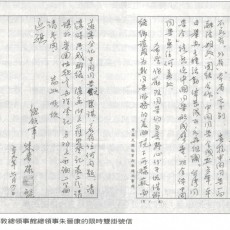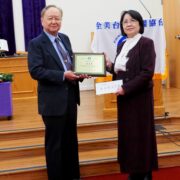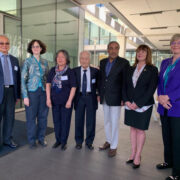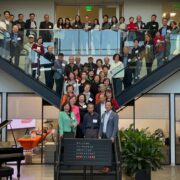Taiwanese Association of America – United States of America
Author: Mu-Sheng Wu
Background
In the 1960s, especially in the years right around 1970 at the height of the Vietnam War, American universities brought a number of Taiwanese graduate students from science and engineering programs into the United States as teaching assistants and research fellows. With this door open, many Taiwanese students were able to go to the United States to study. As a result, nearly every university had a group of Taiwanese students.
At that time, it was typical that when a Taiwanese student arrived at an American University, there would already be an established Chinese Student Association that was not affiliated with China and was actually a Kuomintang organization. If the student was a Kuomintang supporter, not long after his arrival, he’d receive a notice from a district leader asking him to report to the local leaders and instructing him on a number of duties, such as: to cooperate in group activities, to randomly engage in national diplomacy, to promote the culture of the motherland, and to refute heretical ideas. If the student was not Kuomintang-allied, he would also receive an invitation letter from the Chinese Student Association. He might wonder how they knew his address, since no one apart from the university was supposed to know it. Such was the vast and remarkable power of their group.
For numerous reasons, including wanting to relieve a sense of homesickness, trying to acclimate to their new environment, out of political interest, out of curiosity, out of politeness, or just in order to figure out what the group was about, the new students would attend the welcome orientation. Afterwards, many of them would continue to participate, and of course there were also some who only occasionally participated, and some who never attended again. The people in the latter two categories had different opinions; they were mostly Taiwanese.
Firstly, the Taiwanese had an issue with the word “Chinese” in “Chinese Student Association,” since they were from Taiwan, not China. Additionally, the majority of the students in the Chinese Association spoke with a Beijing accent. They also discovered that their Chinese classmates blatantly lied — claiming that the authoritarian government of Taiwan was a free and democratic government, and that the cruel Chiang Kai-shek was a benevolent, beloved, and great man. What disgusted them the most was that the Chinese students took commands from the consulate and were controlled by the Kuomintang. These Taiwanese students were not willing to be bullied in America like they were in Taiwan; in America, they wanted to become people who could stand tall and dignified. Additionally, they realized that the Chinese Student Association could not help them with their homesickness. The only thing they got out of the orientation meeting was a “registration form” that gave the consulate greater control over them, but a lot of them had already been mailed a copy of this form.
Gradually, they met other Taiwanese students through their friends, on campus, at the market, through the Chinese Student Association, and by other means. As they began to eat and talk with one another, they realized that these kinds of gatherings helped them relieve their sense of homesickness and loneliness, and they were also able to express their hatred for the Kuomintang. Once they realized that Kuomintang agents were lurking throughout the campus, they began to be more cautious. When the time was right, there were a few courageous, righteous, and forward-looking Taiwanese students who, disregarding the presence of secret agents, stood up and proposed the establishment of a Taiwanese association. Around 1970, Taiwanese Associations sprouted up on one campus after another, like “bamboo shoots after a spring rain.” During this period, the two most typical examples were the University of Texas Austin’s Taiwanese Association and the Ohio State University Taiwanese Association. Enlightened by their consciences, these Taiwanese students were determined to contribute to Taiwan.
The Taiwanese associations that originally chose not to involve themselves in politics, such as the Taiwanese Association of New York (1976), were not far behind: they began to reinvent themselves. They began caring more about politics, and they worked hard to overthrow the Kuomintang regime to help Taiwan become a new and independent country. Though their bylaws stipulated that they were non-political organizations, in reality, the term “non-political” is in itself, quite a political statement. Under these conditions, the birth of the Taiwanese Association of America was in no way coincidental.
The Establishment of the University of Austin Texas Taiwanese Association
Currently, Austin is a medium-sized city with a population of 660,000, but back in 1969, it was just a small city with a population under 200,000. Austin is the political center of Texas and the state capital; to many Texans, it is also home to the best school in the world: the University of Texas. At that time, there was very limited amounts of industry and commerce, and it seemed to be just the state capital and home to a university.
Before 1969, the University of Texas was the Kuomintang’s “sacred,” and well-cultivated base, the cultivators of which included the Houston consulate, the Kuomintang association (led by Ta-chen Lo, under Kuang-tsai Chang’s command), and the Chinese Student Association. Though the Taiwanese students numbered close to 50 individuals, they had never had their own organization, nor had they ever held Taiwanese student meetings. Nearly all of them participated in the Chinese Student Association, though their participation was often not voluntary. At that time, there were various reasons and hardships that made it impossible not to participate. Their passports had a 3-year validity period, after which they needed to renew their passports in order to extend their stay in the States. The renewal was only valid for another 20 months, after which they could continue to renew their passports, but if they wanted to continue to live in the States, they had no option but to maintain a certain kind of relationship with the consulate. This was the main reason that many Taiwanese students participated in the Chinese Students Association.
In 1969, ten new Taiwanese students arrived at the University of Texas, and brought with them very liberal ideologies, a deep hatred for the Chiang regime’s dictatorship, and discontentment with the Kuomintang’s role in Austin. Though most of them were very concerned about situation in Taiwan and its future, their understanding of the situation in Taiwan was still quite weak, and some even had a deep-seated Chinese complex.
At this time, Mu-Sheng Wu from the East Coast began to take action. He carefully selected Cheng-I Jim Young, Chun San Lee, Chung-nan Chiu, Sheng-chi Wu, Tony Chen, Yao-pen Hung, Ching-chang Chiang, Tsann-wang Yu, Feng-sheng Lin, and Chao-chi Lu, and invited them to visit his home to eat and get to know each other better, as well as to begin conducting Taiwanese student activities in the Kuomintang’s strong point, the south central part of the United States. After this, whenever they were free, concerned about Taiwanese politics, or dissatisfied with the Kuomintang, they would go to Wu’s house to talk, if there was alcohol, they’d drink, and often times they’d talk into the depth of night. On the weekends, the Wu household was often filled with Taiwanese students, who had turned the apartment that Mu-Sheng Wu had rented from the school into their gathering place and rest area. Though their meetings weren’t regular yet, the Taiwanese in Austin were beginning to hold their own gatherings.
Not long after New Year’s Day 1970, they began to prepare public activities for the Taiwanese students, starting with outings. They planned one outing per month, which were planned by a different volunteer each time, and as the number of participants grew, so did their courage. After planning three outings, they decided that they wanted to establish a Taiwanese association, but the biggest issue was who would serve as President. Though they had the courage to organize a Taiwanese association, becoming President held a different level of risk. For this reason, they asked Mu-Sheng Wu for his opinion, but in reality, what they were asking for was not his opinion, but rather for him to become President. Not daring to decline, Mu-Sheng Wu immediately accepted their request.
Though they carried out their preparatory work vigorously, they also did so with great caution. For example, they asked the politically strong Neng-Hsiang Wang, who had once fought with the Chicago consulate at Kansas State University, to avoid attending their early events. They were also careful to avoid leaking any information to the Kuomintang.
In March of that year, they established the Taiwanese association at an Austin church with 40 participants (later the association grew to 60 members), and Mu-Sheng Wu became the first President. For these 40 students to have established a Taiwanese association in the isolated and remote city of Austin, under the watchful eye of the Kuomintang agents, is truly an extraordinary feat.
To avoid being harmed by the Kuomintang, the students of the Taiwanese association registered with the University of Texas as an official student organization — the Formosan Club. Though the school had one Taiwanese professor, since he’d never had contact with the Taiwanese students, nor had he ever expressed any political positions, they had to ask an American professor to serve as their advisor.
The mission and activities of the Taiwanese Association were: to be a non-political organization that helped students connect with each other and assist each other, to help new students settle in, to organize recreational activities and small seminars, and to connect with other local Taiwanese associations.
The Kuomintang agents truly ran rampant; one week after establishment of the association, Mu-Sheng Wu received a letter sent via specified-delivery double registered mail from the Kuomintang consulate in Houston. The letter contained the following demands: (1) to disband the conspiratorial Taiwanese association; (2) to become an agent for the Consul General; (3) to report the phone numbers, addresses, and occupations of any close relatives to the consulate. The purpose of the letter was to intimidate, and though it was written very politely (Kuomintang officials often used a method that involved leaving no trace of their contact; if talked to in person or over the phone, they were very arrogant; but in written letters, they were extremely polite), enclosed in the letter were two editorials that derided those involved in the Taiwanese Independence Movement, which made the letter seem more threatening. For the Taiwanese people’s dignity, as well as the Taiwanese Association’s survival, Mu-Sheng Wu paid no attention to the letter and was determined to take on the consulate’s challenge. The consulate realized that they’d come across a hard nail and decided to retreat, never again bothering Mu-Sheng Wu during his tenure as president.
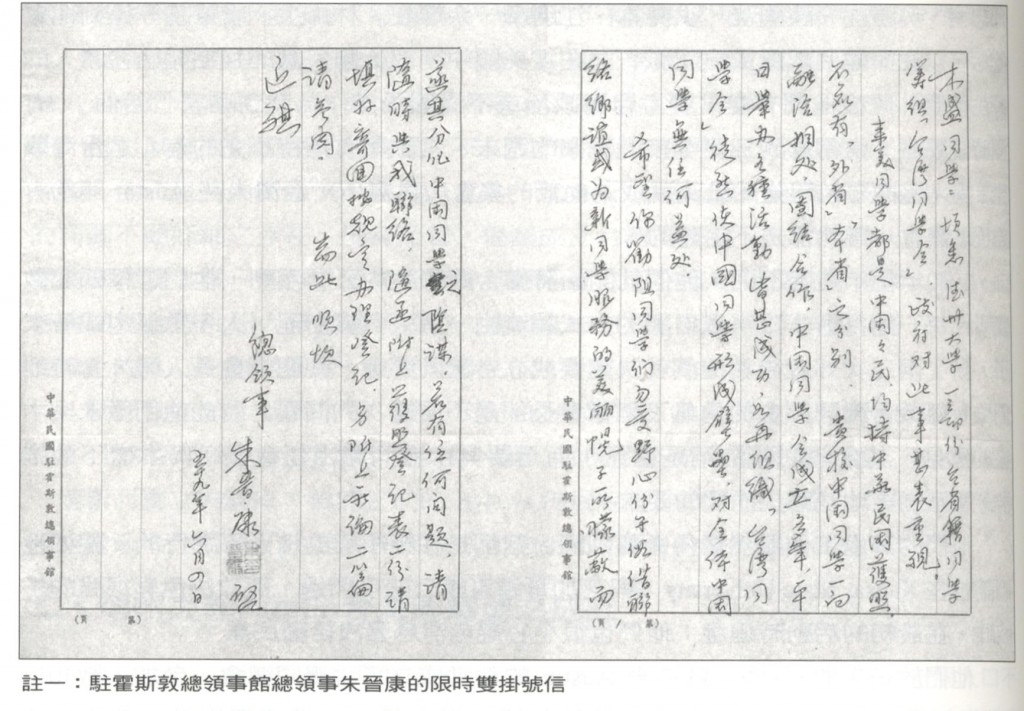
The term length for the presidency was one year. In 1971 the second president, Chun San Lee, came into office. As soon as his term began, officials from the consulate went to his apartment to discuss with him, and of course they used intimidation tactics and the like. Chun San Lee was not swayed by these threats, and he maintained the dignity of the Taiwanese people.
The Birth and Growth of the Taiwanese Association of America
Translator’s note: the Taiwanese Association of America (全美同鄉會) is sometimes referred to as the “Formosan Club of America” by the author, so the translation reflects this preference when specified in the original text. Please note, however, that the Formosan Club of America and the current Taiwanese Association of America are the same organization.
As previously mentioned, in 1969 and 1970, new local Taiwanese associations sprung up like “bamboo shoots after a spring rain,” while the long-established Taiwanese associations in the larger cities became more political. On January 28th, 1970, in order to gather these forces together to better serve the homeland, to improve the situation back home, and to make greater contributions to Taiwan’s future, the Taiwanese Association of the Eastern U.S. (Yi-Ho Cheng), the Taiwanese Association of Los Angeles (Ho Rui Hsu), and the Taiwanese Association of Chicago (Chin-hung Lin) co-authored a letter to the various local Taiwanese associations to propose the establishment of the Taiwanese Association of America. After receiving the enthusiastic support of all local associations, the Formosan Club of America was established in New York on July 1st.
First President: Yi-Ho Cheng
Term: July 1st, 1970 to June 30th, 1972.
Yi-Ho Cheng and Ho Rui Hsu were elected as President and Vice-president respectively. Lung-feng Chen was elected as Secretary, Hsi-hsien Wu as Head of Finance, and Cheng-Shen Fang as the journal editor.
The 28 founding chapters of the Taiwanese Association of America were: Ann Arbor (Yu-chao Wu), Austin (Mu-Sheng Wu), Baltimore (Steven Chang), Binghamton (Franklin Fong-Ming Lee), Boston (Ching-chiang Kuo), Greater Chicago (Chin-hung Lin), Cincinnati (J. Y. Lin), Cleveland (Tu-lung Weng), College Station (Ta-lin Liao), East Lansing (Kun-Mu Chen), Hartford (Wan-chung Yang), Houston (Rung-chang Lin), Ithaca (Wu Hsiung Tsai), Lincoln (Kung-chao Li), Los Angeles (Ho Rui Hsu), Madison (Li-yuan Huang), Manhattan (Kang Lu Wang), New Haven (Ching-chun Chen), Greater New York (Yi-Ho Cheng), Norman (Raymond Wu), Philadelphia (Rui-Ying Li), Portland (Tsung-min Lin), Provo (Chiang-liu Chen), St. Louis (Ying-tsung Lo), Raleigh (Chen-sheng Chang), Seattle (Hsin-I Huang), Storrs (Chao-sung Hsu), and Washington D.C. (Donald C. J. Chen). (Author’s note: the names in parentheses are the Presidents of each chapter.)
The mission of the Taiwanese Association of America was: (1) to promote friendship; (2) to strengthen coordination and cooperation between the local associations; (3) to help resolve social, economic, cultural, legal, and human rights issues that Taiwanese were facing; (4) to promote understanding and goodwill between Taiwanese and American citizens; (5) to enhance cooperation between Taiwanese inside and outside of the island; (6) to serve as a coordination center for the above listed goals.
They officially registered the club with the Office of recorder of Deeds, D.C. under the name “The Formosan Club of America, Inc.” and received their official documents that day. The directors of the club included: Chi-Chin Huang, Yi-Ho Cheng, and Lung-fung Chen; members were: Chi-Chin Huang, Yi-Ho Cheng, Lung-fung Chen, and Winston Tsai (a Washington D.C. lawyer). The validity period of their registration was 10 years.
Yi-Ho Cheng started his term on July 1st, 1970, and ended it on June 30th, 1972, a total term length of 2 years. During his term, the following 6 local Taiwanese associations joined the Taiwanese Association of America: Minneapolis (Shu-mei Chang), Baton Rouge (Wen-yu Tsai), Dallas (His-I Huang), Lawrence (Chi-hsiang Lei), Buffalo (Chun-hsiung Wang), and Rochester (Cheng-hsiao Wu). At the end of Yi-Ho Cheng’s term, the Taiwanese Association of American had 34 chapters.
Second President: Ho Rui Hsu
Term: July 1st, 1972 to August 31st, 1974.
The second President was Ho Rui Hsu from the Taiwanese Association of Los Angeles, and the Vice-president was Chiung-hui Ke from Pittsburg. The only reason that the length of the term was two years and two months, instead of two years, was that there were no candidates for the position, so there was no other option but to extend the length of the term. It was during this term that May Flower became the club journal. Cary S. Huang and others began publishing May Flower in 1969 in Ft. Collins, Colorado, with the purpose of enlightening the Taiwanese consciousness. Later, it was also published in Madison, Wisconsin (1971/7/1); Houston Texas (1971/12/20); and Los Angeles, California by Taiwanese community members or organizations. When May Flower was being published in Los Angeles, the Taiwanese Association of America used it to connect various local Taiwanese associations and their members. Later, on November 20th, 1973, it officially became the journal of the TAA, and the TAA continued to use May Flower as its official publication until it ceased publishing in 1980.
During Ho Ru Hsu’s term, the following chapters were added to the Taiwanese Association of America: Atlanta (Evan Ling), Pittsburg (Edward T. S. Huang), Purdue (Cheng-I Lin), San Francisco (Cheng-hsun Chang), Syracuse (Sheng-I Kuo), Urbana (I-ming Chang), N.Y. Capital (Chao-fu Yang), New Jersey (Pao-ting Cheng), and Athens (Hsin-chi Lin). A total of 9 new chapters, added onto the 34 at the end of Yi-Ho Cheng’s term, brought the TAA’s total chapter count to 43. This large family thriving in the middle of a foreign country was truly magnificent. The only pity was that the parents of this big family didn’t have the right to be parents, and the organization was rather weak. Each chapter still played an important role in their respective areas — enlightening the Taiwanese consciousness and publicizing their cause to the American public. However, since the Taiwanese Association of America’s existence wasn’t crucial to the existence of the separate chapters, the TAA did not have a lot of power to unite the different chapters. Additionally, the United States is a large country, and since at the time, phone calls were expensive and the Taiwanese who traveled to America were poor, most of them communicated through written correspondence. With the added fact that the presidents of university Taiwanese associations often left after graduating, it was generally difficult to maintain a good relationship between the TAA and all of the local branches. Therefore, while there were 43 chapters across the United States, only ten or so maintained regular contact with the TAA.
The work President Ho Rui Hsu completed during his term can be summarized as follows: (written by Vice-president Chiung-hui Ke)
- General work
-
- Continued to encourage and assist Taiwanese communities to establish local Taiwanese associations and join the Taiwanese Association of America
- Collected the membership lists of each chapter in order to compile a register of all the members of the Taiwanese Association of America
- Designed an emblem, anthem, and flag for the Taiwanese Association of America
- Cooperated with the publishers of May Flower; mentioned earlier, so it will not be described in detail here
- Cooperated with other Taiwanese associations
-
- Supported the Taiwanese Self-determination Movement, started by Chang-hui Huang, Wudong Huang, Tsung-yi Lin, and Choan-Seng Song, and fully cooperated with them after the establishment of the Self-determination association.
- Participated in preparations for the World Federation of Taiwanese Associations (WFTA); please refer to “The Establishment of the WFTA” during Mu-Sheng Wu’s tenure as President.
- Held the first East Coast Summer Conference
With the assistance of Christian friends like Chia-hsin Yeh, Hsien-li Huang, and Franklin Fong-Ming Lee, the TAA and the East Coast Christian Alliance decided to co-host “The Fourth East Coast Christian Summer Conference” and “The First Taiwanese Association Summer Conference” on July 19th, 1973 at Camp Taconic in Albany, New York. The leaders of the simmer conferences were Morgan Chang (New York), Pao-ting Cheng (New Jersey), Mingchi Wu and Edward Huang (Pittsburg), and Franklin Fong-Ming Lee (Upstate New York). After the summer conference, the majority of the Taiwanese association representatives advocated for the continuation of the summer conference. Chiu-Sen Wang of the Syracuse Taiwanese Association agreed to organize the 1974 East Coast Summer Conference, and since then, the East Coast Summer Conference has continued year after year. It also inspired the consecutive establishment of the West Coast, Southern, and Southwestern Summer Conferences. The summer conferences have become some of the TAA’s most important regional events.
- Friendly Softball Tournament
In the early 1970s, Taiwan’s success in the Little League aroused enthusiasm for softball amongst the overseas Taiwanese community. Many Taiwanese associations organized their own softball teams. Thus, the TAA considered softball tournaments as a way of promoting cooperation between chapters in the same regions. Unfortunately, however, due to the economic circumstances of the Taiwanese American community and their associations at that time, it was impossible to organize nationwide tournaments.
- Exposing the Evils of the Kuomintang at Williamsport
From 1969 to 1973, Taiwan’s little league baseball team came to Williamsport, Pennsylvania to represent Asia in the Little League World Series. All of the Taiwanese associations on the East Coast organized a trip to Williamsport to cheer on the team. While watching the game, they held up signs with words like “Go Team Taiwan,” “The Taiwanese Team is not the Chinese Team,” and “Go Go Taiwan.” In order to have an even larger effect, one year they even hired a small plane to circle around the field with banners that read “Long live Taiwanese Independence” and “Go Go Taiwan.”
The Kuomintang also mobilized its own party members — the Chinese Student Association, the overseas Chinese community they controlled, and hired gangsters — to hold signs reading “Go Team China” and make noise near the Taiwanese cheering squad. They were simultaneously cheering on the Chinese team and cursing at the Taiwanese audience members. Their hired gangsters also mixed into the Taiwanese group and stole flags from some of the Taiwanese individuals. When they saw the small plane flying its banners, they were very angry, and audience was clearly divided into “Taiwanese” and “Chinese.”
In 1972, the Taiwanese team won the World Series, and the second the game ended, a punch was thrown. Soon, Kuomintang naval soldiers and thugs, who’d been sent to Connecticut to train and stir up trouble, rushed into the group of Taiwanese audience members with wooden sticks in hand, and began to beat them. Some of the Taiwanese people immediately protected themselves with their flag poles. This armed fight was finally broken up by the Williamsport police and helicopters, but by this time, a lot of Taiwanese community members were already injured. Only later did we learn that this group of naval soldiers had been deceived, believing that they’d been sent to fight “Chinese communists.” When they recognized some of these so-called “Chinese communists” as people they knew from Connecticut, they realized that they’d been tricked.
At the beginning of August 1973, the TAA learned that the Taiwan Giants would come back to defend their championship, so they cooperated with the Taiwanese Association of New York (Jyu Hsiung Fang) and the Taiwanese Self-determination Association (Pastor Choan-Seng Song) to create a plan to expose the Kuomintang’s violent and abusive behavior towards the Taiwanese audience members at the Little League tournament, and to protect the safety of their fellow Taiwanese. Association members from New York like Choan-Seng Song and Jyu Hsiung Fang sent letters to the citizens and local newspapers of Williamsport. Vice-president Chiung-hui Ke of the TAA wrote to the organizers of the Little League tournament, the Pennsylvania Police Department, and the Williamsport Police Bureau. Our appeal resonated with the citizens, many of whom wrote letters to the organizers of the tournament and the police chief.
The Taiwan Giants won that year’s championships 12-0. Though the Kuomintang underlings were as brazen as ever, doing their best to provoke us, thanks to our preparations, they were unsuccessful. After the event, TAA wrote a thank you letter to all the involved groups to thank them for their efforts in bringing the tournament to a satisfactory conclusion.
The Taiwanese Association of America finally caught the attention of the Nationalist Government. In early 1974, the Nationalist Government, through someone named Mr. Chen, extended an invitation to President Ho Rui Hsu, Vice-president Chiung-hui Ke, and three other Taiwanese association representatives to travel back to Taiwan and get a better understanding of the country’s current situation. After the TAA discussed with leaders of other organizations, they feared that they’d be force-fed Kuomintang propaganda during this trip, and that they might negatively affect the individuals and organizations fighting against the Nationalist Government from inside the island. Thus, they declined the invitation.
Journals, Newsletters, and Magazines
It could be said that all the members of TAA were very talented scholars, and the first step of a scholarly rebellion is the writing of articles and distribution of publications. It’s hard to estimate just how great the influence of these publications was. In addition to communicating ideas and transmitting messages, they also played a role in enlightening, purifying, and influencing ideas. There were numerous publications that TAA collaborated with its branch chapters to produce. Some of the representative publications include:
- TAA Publications
- The Taiwanese Association of America Special Issue
- May Flower
- Taiwan Culture
- Newsletter
Of these publications, Taiwan Culture and Mayflower were very important, and need to be explained further. When Maysing Huang was serving as President, Fang-Ming Chen was invited to be the Editor-in-Chief for Taiwan Culture. Thanks to Fang-Ming Chen’s talent and hard work, the magazine became an extremely high-quality literary arts magazine that was the pride of the overseas Taiwanese people. Taiwan Culture was different from the average Taiwanese association publication, because it was not used for communication.
The first issue of May Flower was published on August 1st, 1969 in Ft. Collins, a college town in Colorado. It was founded by Cary S. Huang and a group of Taiwanese people, with the intention of enlightening people’s thoughts. The cover of the first issue has an image of the island of Taiwan, and a line by Percy Bysshe Shelley: “O, wind, if winter comes, can spring be far behind?” Everyone knows what “winter” and “spring” represent, and of course, it is the same “spring” as in the name May Flower. (Translator’s note: the literal translation of the publication’s Chinese name, Wangchunfeng, is “Hope Spring Wind.”)
On July 1st, 1971, May Flower left Ft. Collins and travelled to Madison, Wisconsin to be edited and distributed by the Taiwanese association members there. Since then, May Flower embarked on a journey, “wandering” throughout the United States. On December 20th, 1971, it was published in Houston, Texas; later, on July 20th, 1973, it was taken over by Taiwanese in Los Angeles, California. On November 20th, 1973, it became the official publication of the Taiwanese Association of America. Since then, the publishing location has changed with the TAA’s President. For example, on September 20th, 1974, it was published in Washington D.C., and on September 20th, 1976, it was published again in Houston, Texas.
At the end of 1978, after Taiwanese in Boston, Massachusetts fought for the publication, May Flower finally left Houston and was printed in Boston on January 15th, 1979. Thanks to their use of moveable type to print it, and the fact that an artist designed the cover and the editorial board carefully prepared the contents, May Flower matured overnight. Unfortunately, it later lost prominence, and May Flower was forced to close operations at the end of 1980, before it had finished fighting its “war.”
From 1973 until the end of 1980, May Flower lived seven spectacular years under the operation of the Taiwanese Association of America.
- Chapter Publications
- Newsletter, Taiwanese Association of Greater New York
- Formosans in St. Louis, Taiwanese Association of St. Louis
- Newsletter, Taiwanese Association of Columbus
- Newsletter, Taiwanese Association of Chicago
- Newsletter, Taiwanese Associations of Ann Arbor, Detroit, and East Lansing
- Taiwan, Taiwanese Association of Purdue
- Los Angeles Chapter Journal, Taiwanese Association of Los Angeles
- Island of Immortals, Taiwanese Associations of New Jersey, Philadelphia, and others
Presidents of the Taiwanese Association of America
From the establishment of the Taiwanese Association of America in 1970 up to 1990, there were 10 Presidents, that each served two years. Shortly into the beginning of his term, the fourth President, Kuo Shih Yeh, went abroad for personal reasons, and was replaced by Cheng Y. Eddie Chuang.
Yi-Ho Cheng: July 1st, 1970 to June 30th, 1972
Ho Rui Hsu: July 1st, 1972 to August 30th, 1974
Mu-Sheng Wu: September 1st, 1974 to August 31, 1976
Kuo Shih Yeh/Cheng Y. Eddie Chuang: September 1st, 1976 to December 31st, 1978
Tan-Sun Mark Chen: January 1st, 1979 to December 30th, 1980
Ming-che Lin: January 1st, 1980 to December 31st, 1982
Tu Chen: January 1st, 1983 to December 31st, 1982
Ying-min Hsieh: January 1st, 1985 to December 31st, 1986
Maysing Huang: January 1st, 1987 to December 31st, 1988
Minlu Chai: January 1st, 1989 to December 31st, 1990
Excerpt from Self-awareness and Identity – Compendium of Overseas Taiwanese Movements from 1950~1990 (June 2005)
Translated from 76. 全美台灣同鄉會/吳木盛/12/2014

